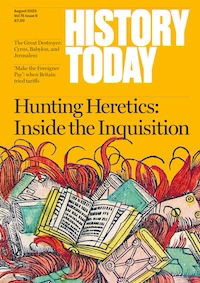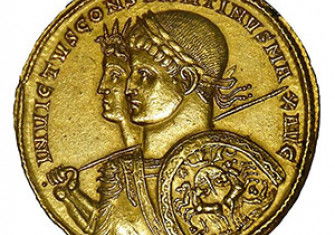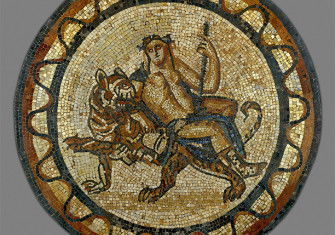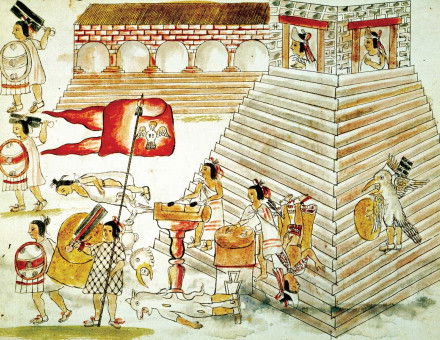Migration in Roman Britain
How free movement in the Roman Empire resulted in a multicultural Britain.
After Britain became part of the Roman Empire in AD 43, the island and its inhabitants were integrated into the wider Roman world. This drastically increased the possibilities for migration to and from the newly minted province. Yet for the majority of Britons, little changed. Most chose to spend their lives in their local communities, remaining close to their place of birth. Some, however, emigrated from their homeland and travelled great distances across the Mediterranean, often as members of the Roman army. At the same time, people migrated to Britain from across the Empire. Although this usually happened as a result of military service, many also arrived as traders and slaves.
An interesting case is that of Barates of Palmyra, a Syrian who travelled to Britain, probably as a merchant. On arrival, he bought a slave named Regina, who had been born into the Catuvellauni tribe of southern Britain. Afterwards, Barates freed Regina and the two married. From the depiction of Regina on her tombstone, by the time of her death at 38 she had become quite wealthy. Barates himself lived to be 68, dying at Corbridge near Newcastle. It is amazing to think that Barates had left his home in the Levant to travel across the Empire, married a Briton and ended his life in northern England. Even Regina, while not travelling as far, had moved from southern Britain to the northern edge of the Roman world.
As a Roman province, Britain became a diverse, multicultural society. This has long been known from the textual sources and material remains, but now scientific analyses are also enhancing our knowledge of migration to the island. One recent study in particular, published in The Journal of Archaeological Science, used scientific techniques to shed light on the origins of some of London's earliest inhabitants. The researchers applied lead and strontium isotope analyses to the dental enamel of 20 people buried in the ancient settlement between the first and fifth centuries AD, the first large scale study of its kind for Roman Britain. They revealed that 12 of the individuals probably grew up around Londinium, while another four probably grew up elsewhere. The results for the remaining four were inconclusive.
Intriguingly, although one woman buried with ‘Germanic’ items was shown to be non-local, as one might expect, a man from the same burial ground, also interred with ‘Germanic’ items, was shown to be from Londinium, rather than abroad. From his burial alone, he might have been regarded as an immigrant, but the scientific data suggests otherwise. Of the three remaining migrants identified, one – thought to be only eight years old at death – appears to have come from near the Rhine Valley, despite being buried with typically British grave goods. The others were traced to the Mediterranean region, with one perhaps from Rome. This all adds to the increasing data, derived from scientific analyses, about migration to Britain in Roman times. It seems that most major Roman towns included large foreign populations – men, women and children – who brought their own cultural traditions, intermarried into the local population and over time acculturated.
But what about British emigrants? Surprisingly, as discussed in a recent article in the journal Britannia, although there is increasing evidence for migration to Britain during the Roman Empire, it's rare to find written evidence for British emigrants: in fact, only around 40 examples are known. These lived across the Mediterranean world, from Bordeaux, Rome and Solin in Croatia, to Lambaesis in Algeria. Some were quite important, such as Marcus Minicius Marcellinus, a senior centurion, originally from Lincoln and stationed in Mainz. The number of British emigrants, however, was certainly much higher than the evidence allows us to see, for many would not have left inscribed monuments for us to find.
The authors of the Britannia study also highlight an intriguing case of a Briton living abroad: a centurion named Titus Quintius Petrullus, who, after the above-mentioned Marcus Minicius Marcellinus, is only the second known centurion of British birth (although there are a few other potential possibilities). The only evidence for Petrullus' life is written on his tombstone, discovered in Bostra, Syria and dated to the second or third centuries AD; this relates that Petrullus was a centurion of legio III Cyrenaica and died at the age of 30.
What else can we say about this man's life? The study's authors argue that his cognomen, Petrullus, suggests a Celtic background. And, because he was relatively young for a centurion, he was probably directly commissioned, as opposed to having risen up the ranks. For a man to be directly commissioned, he would normally have held municipal offices first, suggesting that Petrullus was someone of high importance – perhaps a member of the local British elite.
Through such studies, the extent of migration in the Roman world is becoming clearer. More than just a chance for sightseeing (holidays around the Empire were certainly enjoyed by the Roman elite), travel could provide new opportunities, such as a better life in a distant land. Migration and the benefits of free movement, though currently contentious topics, are nothing new. Just ask Barates.
Garry Shaw is the author of The Egyptian Myths: A Guide to the Ancient Gods and Legends and The Pharaoh: Life at Court and on Campaign. He also writes generally on heritage and travel.






